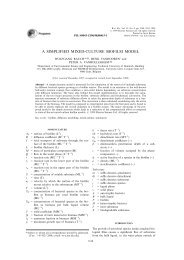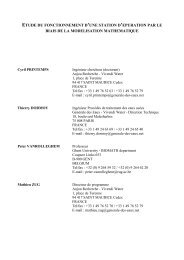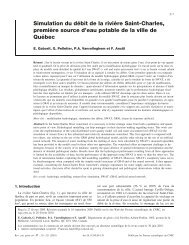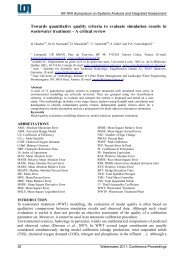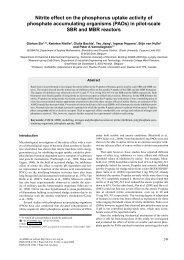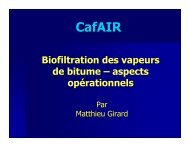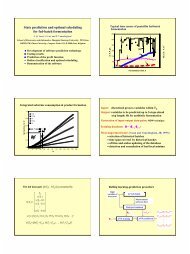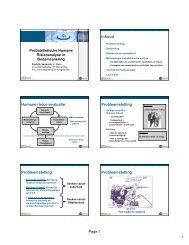Modeling 17α-ethinylestradiol removal in membrane bioreactors
Modeling 17α-ethinylestradiol removal in membrane bioreactors
Modeling 17α-ethinylestradiol removal in membrane bioreactors
Create successful ePaper yourself
Turn your PDF publications into a flip-book with our unique Google optimized e-Paper software.
Poster Session<br />
WWTmod2012<br />
The same trend was observed at the beg<strong>in</strong>n<strong>in</strong>g of the 7h-HRT phase. The <strong>removal</strong> decreased from<br />
97% to 28% due to the saturation of the sorption sites and then, biodegradation <strong>in</strong>creased the<br />
<strong>removal</strong> efficiency to 68%. Results from this experiment showed that biomass required an<br />
adaptation phase of about 10 days before it could biodegrade EE2. The proposed model is rather<br />
good at describ<strong>in</strong>g the beg<strong>in</strong>n<strong>in</strong>g of phase 3, where only sorption is a factor <strong>in</strong> the <strong>removal</strong> of EE2.<br />
Then, the model results show that the Verhulst adaptation k<strong>in</strong>etics was quite successful <strong>in</strong><br />
<strong>in</strong>tegrat<strong>in</strong>g EE2 co-metabolism <strong>in</strong> the model.<br />
Model application<br />
Several simulations were performed <strong>in</strong> order to evaluate the <strong>removal</strong> efficiency of EE2 <strong>in</strong> different<br />
operat<strong>in</strong>g conditions. The <strong>removal</strong> efficiencies reported <strong>in</strong> Table 5 were obta<strong>in</strong>ed after a steadystate<br />
was achieved for HRT values of 20h and 7h. The results show that the MBR rema<strong>in</strong>s efficient<br />
at remov<strong>in</strong>g EE2 when the HRT is 20h, even at low temperature (Exp. 2), with a lower<br />
aerobic/anoxic ratio (Exp. 3), and at an SRT of 5 days (Exp. 4). However, when the SRT is lowered<br />
to 2 days (Exp. 5), the complete absence of nitrification has a significant effect on the <strong>removal</strong> of<br />
EE2. Moreover, <strong>in</strong> that specific scenario, the TSS concentration <strong>in</strong> the wasted sludge is less than 1.5<br />
g/l, therefore, nearly 30% of the <strong>in</strong>fluent EE2 is discharged with the sludge as soluble EE2. When<br />
the HRT was set to 7h, the operat<strong>in</strong>g conditions had a greater impact on the <strong>removal</strong> efficiencies.<br />
The lower temperature altered nitrification, but it <strong>in</strong>creased the TSS concentration <strong>in</strong> the reactor,<br />
which allowed more sorption to occur. At a SRT of 2 days, no nitrification and co-metabolism was<br />
observed, which means that EE2 was only removed by sorption.<br />
Table 5. Removal percentages at steady-state under various operat<strong>in</strong>g conditions.<br />
Exp. 1 Exp. 2 Exp. 3 Exp. 4 Exp. 5<br />
SRT (d) 50 50 50 5 2<br />
Temperature (°C) 20 5 20 20 20<br />
Aeration 2h/1h (no) 2h/1h (no) 1h/2h (no) 2h/1h (no) 2h/1h (no)<br />
Removal % @ HRT 7h 71 65 71 60 26<br />
Removal % @ HRT 20h 90 88 89 86 61<br />
CONCLUSION<br />
In this paper, an add-<strong>in</strong> model to ASM1 that describes the fate of the synthetic hormone <strong>17α</strong><strong>eth<strong>in</strong>ylestradiol</strong><br />
<strong>in</strong> a MBR pilot was presented. The proposed model was able to adequately<br />
represent the different <strong>removal</strong> phases, such as the dynamically faster sorption process <strong>in</strong> the first<br />
10 days and the co-metabolic mechanism that required an adaptation period modeled with a<br />
Verhulst k<strong>in</strong>etic. Various scenarios were analyzed and showed that the low SRT values had a<br />
significant impact on the <strong>removal</strong> of EE2 because it alters both nitrification and co-metabolism.<br />
ACKNOWLEDGEMENT<br />
The authors would like to thank Benoît Marrot and Nicolas Roche from M2P2 <strong>in</strong> Marseille, France<br />
for the experimental data collected. They also thank the Canada Research Chair <strong>in</strong> Water Quality<br />
<strong>Model<strong>in</strong>g</strong> and the Canadian Water Network project EC-2 for f<strong>in</strong>ancial support.<br />
170



